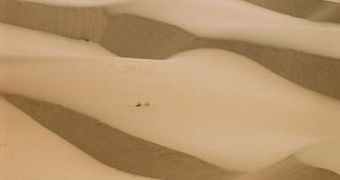Today, Sahara is a huge desert area, with erratic dunes (ergs) and plains covered by rugged rocks (hamada), punctuated by mountains with heights of up to 3,400 m (11,000 ft), covering 8.8 million square kilometers (3.3 million square miles), a surface bigger than that of Australia. At great distances one from another, one can find modest bursts of life, the oases. This desert is supposed to be at least 2.5 million years old. During the last 40,000 years, the borders of the desert have moved southward and northward and, in particular periods, the desert has even disappeared completely, the sand dunes being replaced by wooded savannas. 18,000 to 8,000 years ago, during the last Ice Age, Sahara reached its peak, having moved 400 km (250 mi) south from its current location.
6,000-8,000 years ago, the rainfall was abundant, and Neolithic rock paintings found in the Tassili n'Ajjer Mountains and other areas of Sahara depict crocodiles, ostriches, rhinos, giraffes, buffaloes, hippopotamus and elephants, encountered today only in Africa, south of Sahara, but also oryx antelopes and gazelles. The Sahara was filled with lakes in the region of modern Niger and people hunted antelopes, while its mountains were covered by forests. After that, 4,500 years ago, the region turned into the arid desert we know today.
A new research published in the Science journal shows that this change occurred gradually over 3,000 years, based on the analysis of sediments from a Saharan surviving lake, a theory that comes to contradict the idea that the Sahara turned into a desert in a rapid manner.
Summer monsoon rains started to modify Sahara about 12,500 years ago. But 7,000 years ago, decreased solar radiation weakened the African monsoons, resulting in the aridification of the area. Previous studies analyzing Atlantic dust deposits had found that Sahara's aridification took place in just a few hundred years.
But the team led by Stefan Kr?pelin, a geologist from the University of Cologne in Germany, considered that a stronger proof could come from lake sediments. Most Saharan lakes have dried over the past 7,000 years, and this is why the finding of Lake Yoa in northern Chad was a stretch of luck.
The team investigated 9 m (30 ft) of the lake's sediment, analyzing the remains of animal and plant life, dust deposition, and the lake's salt content over the millennia. The sediments showed a gradual change in the ecosystem occurring from 6,000 to 2,700 years ago, meaning not as rapid as previously believed.
Even so, this was an "abrupt climate change, meaning it was still difficult for animals, plants, and even people to adapt," said Richard Alley, a geoscientist at Pennsylvania State University in State College.

 14 DAY TRIAL //
14 DAY TRIAL //